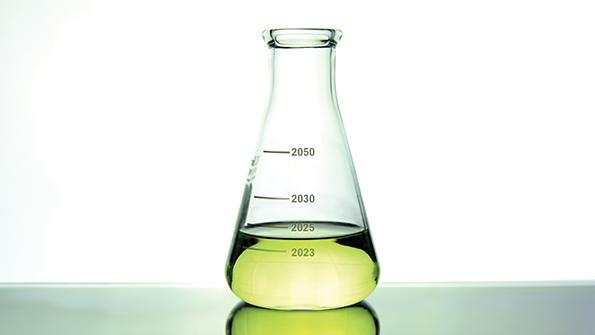This article is published in Air Transport World, part of Aviation Week Intelligence Network (AWIN), and is complimentary through Jan 20, 2024. For information on becoming an AWIN Member to access more content like this, click here.

The airline industry committed to a 2050 carbon net zero target at the IATA AGM in the fall of 2021, a year before ICAO did. And airlines are proving they are serious about that commitment even though it involves significant additional cost.
IATA estimates that airlines, which collectively posted losses of $183 billion in the years 2020-2022 because of the pandemic, will have spent $500 million extra on purchasing sustainable aviation fuel (SAF) in 2023, an amount expected to increase to $2.4 billion in 2024.
Oil and gas companies, however, are standing in the way of making SAF both more available and more affordable.
At IATA’s annual forecast and media briefings in Geneva in December, chief economist and SVP sustainability Marie Owens Thomsen issued a stark warning: “The glass is more empty than full.” She was referring to the relatively still low levels of investment going into building up production capacity for SAF. Owens Thomsen criticized investors who—understandably—prefer traditional oil and gas companies because profits are much higher.
“The investment proposition has to be attractive,” she said. “ESG [environmental, social and governance] ratings only intervene at the margins.” In other words: Many people talk about the need to invest in sustainable technologies in aviation, but nowhere near enough is being committed.
SAF is at the core of aviation’s environmental transformation and critical to its success. SAF is available now and it works. Other technologies that would more fundamentally change aviation’s carbon footprint, including hydro-electric-powered aircraft, are in various stages of development but are not going to have a significant impact in the time available, particularly in long-haul air travel.
But the SAF dilemma—a chronic supply-versus-demand imbalance—also shows the extent to which the airline industry is dependent on others in achieving its targets because it does not have the financial means to fund SAF development on its own. That is also true in other areas: aircraft and engine manufacturers not delivering fuel-efficient aircraft on time; and airports and governments capping flight operations and introducing punitive measures to curb the sector’s environmental impact rather than incentivizing SAF development.
In 2022, 0.24 million tons of SAF were produced globally, according to IATA. The association expects that to have doubled to 0.5 million in 2023. But IATA director for net zero transition Hemant Mistry made clear airlines were expecting “significantly greater output” of SAF for 2023. Next year, IATA hopes fuel producers will make available 1.5 million tons of SAF, which will still be a tiny fraction of what is needed. Meanwhile, the number of oil wells increased by 6% in 2023 at an expected GDP growth of 3%. “This does not make sense,” Owens Thomsen said.
IATA estimates that the industry will need 500 million tons of SAF in 2050, or 1,000 times the volume produced this year. To meet the recently established target of a 5% reduction in CO2 emissions by 2030, formulated by ICAO’s Third Conference on Aviation and Alternative Fuels (CAAF/3) in Dubai in November, around 14 million tons of SAF will have to be available in 2030, essentially 10 times the amount targeted for 2024.
There is no shortage of projects announced. According to Mistry, 10.3 million tons of SAF could be produced based on incentivizing policies and programs such as the US Inflation Reduction Act, which was warmly welcomed by the airline industry. Another 6.7 million tons could be produced via mandates, but in some cases SAF will be shipped from the US to faraway locations because of the lack of regional SAF plants. Airlines have committed to buying around 13 million tons by 2030 when all of their voluntary pickup agreements are added up, proving that demand for SAF is strong.
What is also worrying is that only 3% of total renewable fuel production is SAF. For the CAAF/3 vision, this needs to grow to 25%-30% by 2030.
The key question is whether there will be enough SAF production and how quickly can it be ramped up. So far, the outlook is not positive. As Owens Thomsen pointed out, oil and gas producers are investing only 3% of their revenues into renewable energy. The picture will likely only change once investment in alternative energies becomes at least as attractive as in fossil fuels.
Meanwhile, the COP28 climate change summit in December, also controversially staged in Dubai, ended with only a non-binding agreement “to transition from fossil fuels in a just, orderly and equitable manner” versus an original pledge to phase out fossil fuels. While the agreement was still hailed as a major achievement, it likely will not tilt investment decisions in favor of renewable energy to the extent that the aviation sector needs in the net-zero goal timeframe. Any COP28 deal, of course, required the agreement of all 198 countries and the power of those nations dependent on oil, gas and coal was evident.
For aviation, that is more bad news. As Owens Thomsen succinctly put it: “There are solutions for replacing fossil fuels. There are no solutions for replacing aviation.”





